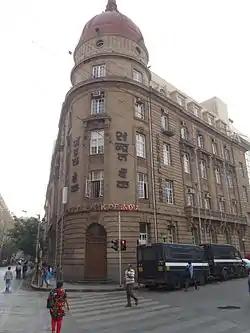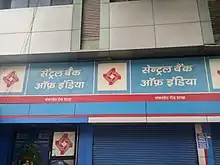Central Bank of India
Central Bank of India, a government-owned bank, is one of the oldest and largest commercial banks in India. It is based in Mumbai which is the financial capital of India and capital city of state of Maharashtra.[3]
 Central to You Since 1911 | |
 | |
| Type | Public |
|---|---|
| BSE: 532885 NSE: CENTRALBK | |
| Industry | Banking Financial services |
| Founded | 21 December 1911 |
| Headquarters | Mumbai, Maharashtra, India |
Key people |
|
| Revenue | |
| Total assets | |
| Total equity | |
| Owner | Government of India (92.39%) [2] |
Number of employees | 33,481 (2020)[2] |
| Capital ratio | 11.72% (2020)[2] |
| Website | www |
It is one of twelve public sector banks in India to get recapitalised in 2009.[4]Despite its name it is not the central bank of India. It is a public bank. In a merging initiative of the NDA government, Central Bank of India is kept as a separate entity owing to its pan-India presence.
Central Bank of India has approached the Reserve Bank of India (RBI) for permission to open representative offices in five more locations – Singapore, Dubai, Doha and London.[5]
As on 31st March 2020, the bank has a network of 4,651 branches, 3,642 ATMs, ten satellite offices and one extension counter. It has a pan-India presence covering all 28 states, Seven out of eight union territories and 574 district headquarters out of all districts in the country.[2]
History

The Central Bank of India was established on 21 December 1911 by Sir Sorabji Pochkhanawala with Sir Pherozeshah Mehta as Chairman,[6] and claims to have been the first commercial Indian bank completely owned and managed by Indians.
Early-20th century
By 1918 it had established a branch in Hyderabad. A branch in nearby Secunderabad followed in 1925.
In 1923, it acquired the Tata Industrial Bank in the wake of the failure of the Alliance Bank of Simla. The Tata bank, established in 1917, had opened a branch in Madras in 1920 that became the Central Bank of India, Madras.
Central Bank of India was instrumental in the creation of the first Indian exchange bank, the Central Exchange Bank of India, which opened in London in 1936. However, Barclays Bank acquired Central Exchange Bank of India in 1938.[7]
Also before World War II, Central Bank of India established a branch in Rangoon. The branch's operations concentrated on business between Burma and India, and especially money transmission via telegraphic transfer. Profits derived primarily from foreign exchange and margins. The bank also lent against land, produce, and other assets, mostly to Indian businesses.[8]
Post-World War II
In 1963, the revolutionary government in Burma nationalized Central Bank of India's operations there, which became People's Bank No. 1.[9]
In 1969, the Indian Government nationalized the bank on 19 July, together with 13 others.

In the 1980s the managers of the London branches of Central Bank of India, Punjab National Bank, and Union Bank of India were caught up in a fraud in which they made dubious loans to the Bangladeshi jute trader Rajender Singh Sethia. The regulatory authorities in England and India forced all three Indian banks to close their London branches.
Central Bank of India was one of the first banks in India to issue credit cards in the year 1980 in collaboration with Mastercard.
On its 108th Foundation day Central Bank of India launched its first step towards robotic banking, a robot named "MEDHA".
See also
References
- "Dena Bank, Punjab & Sindh Bank, Central Bank of India get new chairpersons". The Economic Times. 24 May 2018. Retrieved 3 September 2018.
- "Annual Report of Central Bank of India" (PDF).
- Central Bank of India Archived 3 March 2016 at the Wayback Machine. Central Bank of India (19 April 2011). Retrieved on 31 March 2014.
- "18 govt banks to be recapitalised". Business Standard India. Business-standard.com. 18 February 2009. Retrieved 2 August 2010.
- "Central Bank of India to expand overseas". Rediff.com. Retrieved 2 August 2010.
- "Central Bank IPO to open on 24 July". The Hindu. Chennai, Tamil Nadu India. 14 July 2007. Retrieved 5 July 2008.
- Raychaudhuri, Tappan, Irfan Habib, & Dharma Kumar, eds. (1983) The Cambridge Economic History of India: Volume 2, c.1751-c.1970. (CUP Archive). p. 782. ISBN 9780521228022
- Turnell, pp. 116–7.
- Turnell, p. 226.
Cited sources
- Turnell, Sean (2009) Fiery Dragons: Banks, Moneylenders and Microfinnance in Burma. (NAIS Press). ISBN 9788776940409